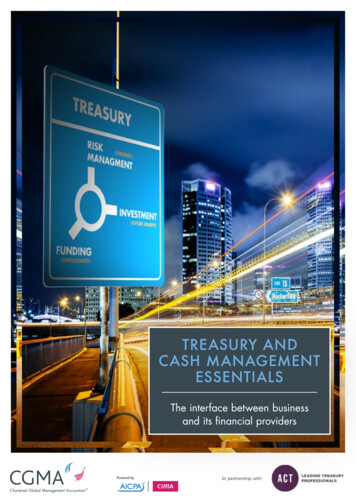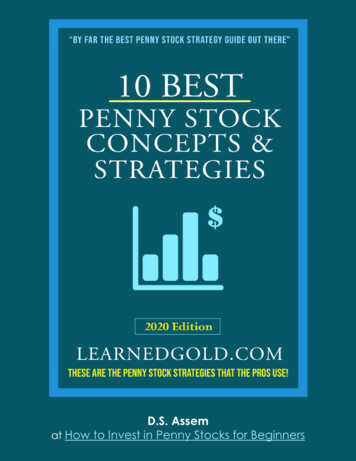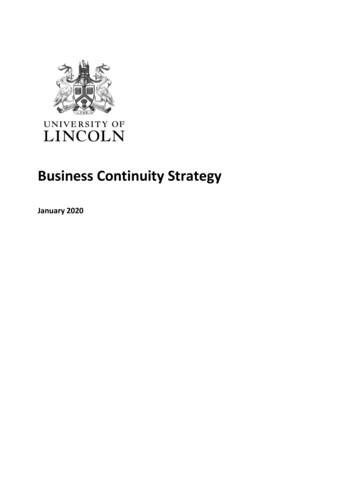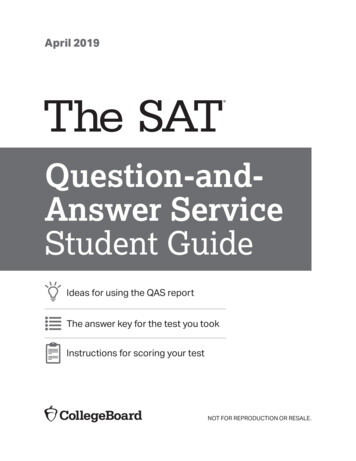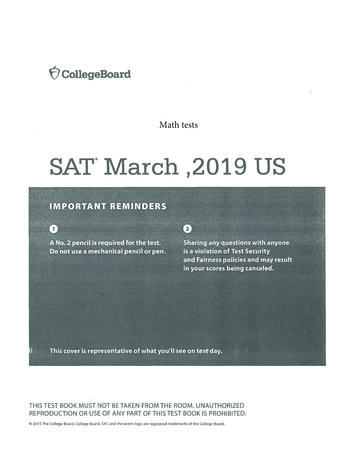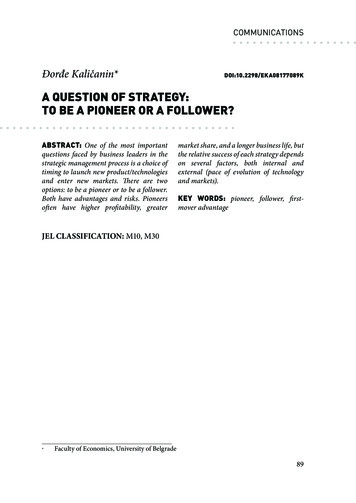
Transcription
COMMUNICATIONSĐorđe Kaličanin*DOI:10.2298/EKA08177089KA QUESTION OF STRATEGY:TO BE A PIONEER OR A FOLLOWER?ABSTRACT: One of the most importantquestions faced by business leaders in thestrategic management process is a choice oftiming to launch new product/technologiesand enter new markets. There are twooptions: to be a pioneer or to be a follower.Both have advantages and risks. Pioneersoften have higher profitability, greatermarket share, and a longer business life, butthe relative success of each strategy dependson several factors, both internal andexternal (pace of evolution of technologyand markets).KEY WORDS: pioneer, follower, firstmover advantageJEL CLASSIFICATION: M10, M30*Faculty of Economics, University of Belgrade89
Đorđe Kaličanin1. IntroductionThe question of first-mover advantage has long been a subject for intensediscussion by economists and business people. It is recognized that first marketentry rewards pioneers, the main initial reward being the biggest market share(Urban et al, 1986). This reward decreases over time as new firms enter, forcingpioneers to take actions to increase and/or defend market share. However, marketshare is often not highly correlated with other important performance measures(profitability, survival, or sales growth) in new industries, and this has led tochanges in business strategy (VanderWerf, Mahon, 1997).Historically the advantages of being a pioneer have been promoted to a muchgreater extent than the risks (Lieberman, Montgomery, 1998). The actual outcomedepends on the initial resources of the pioneer, as well as on the resourcesand capabilities subsequently developed in response to those of the followers.Environmental change certainly provides opportunities to first-movers, butfirms must initially possess the organizational skills and resources to capitalizeon such opportunities (Kerin et al, 1992). Additionally, the question of whetherto be a pioneer or a follower is of increasing importance in the modern Age ofInformation/Uncertainty.Speed of entry into any market is always of great competitive importance. Perhapsan enterprise intends to develop a new product or a novel technology to generatenew products, creating a new industrial sector, or even a whole new industry.Alternatively a company wants to be first to invade a hitherto unexploited nationalor regional market. In all cases, companies are trying to beat the competition.This is superficially similar to an athletic contest, in which every runner tries tofinish first, but in business, the race never ends. Competitive advantage has tobe continuously maintained. A temporary innovation-based monopoly has to betransformed into a sustainable long-term process or product. However, there arecompanies that consciously choose to follow, rather than innovate, believing thisto be a more advantageous strategy.Pioneering and first-move advantage can be achieved in several ways: 1) bymaking new products, 2) by using a new process, or 3) by entering a new market(Heiens et al, 2003). In all cases, pioneers create new market demand for theirproducts/services and continue to satisfy that demand before other enterprisesenter the same market. It has also been claimed that first-move advantage canbe established by new advertising campaigns, initiating price changes, and theadoption of new distribution techniques.90
A QUESTION OF STRATEGY: TO BE A PIONEER OR A FOLLOWER?The first two cases (new product or new process) fall into the category oftechnological pioneering. Technological pioneering refers to the development andcommercialization of an emerging technology in pursuit of profits and growth(Zahra et al, 1995: 144). The third case is described as market pioneering, whenan enterprise with established products and technology is the first to enter a newmarket. Both technological pioneers and market pioneers, through their timingand actions, are first-movers. Other companies are followers. The latter can bedivided into early or late followers (or entrants). Early followers enter the marketsoon after the pioneer; late followers enter after more time has elapsed.In any company, the choice of whether to be a pioneer or a follower must beincorporated in the strategic planning process. A pioneer strategy is compatiblewith the choice of a broad or a focused differentiation strategy. A follower strategyis compatible with the choice of a broad or a focused low-cost strategy (analogousto Kaplan, Norton, 2004).2. Advantages and Risks of Pioneer and Follower StrategiesPioneers gain advantage by making first moves in technology, product ormarketing innovation. These advantages are called first-mover advantages. Otherenterprises are followers, they aim to maximize the late-mover advantages and tominimize late-mover disadvantages.First-mover advantages are: 1) owning the positive image and reputation of beinga pioneer, 2) reduction of total costs through control of new technology, andsupply and distribution channels, 3) the creation of a base of loyal customers,4) having the ability to make imitation by competitors as difficult as possible(Thompson, Strickland, 2003: 193).Pioneers try to make a competitive advantage through being first in a new field.Building a competitive advantage is a time consuming process (time is thehorizontal axis on figure 1) and is called the build-up period. This period canbe minimized if an enterprise already has the necessary resources in place andthe customer response is positive and rapid. Build-up periods can be longer ifdemand growth is weak, or the technology takes several years to perfect, or if ittakes time to establish manufacturing capacity.The size of advantage is shown on the vertical axis. It can be large (as inpharmaceuticals, where patents result in a substantial advantage), or small (as91
Đorđe Kaličaninin the fashion industry, where popular designs can be imitated quickly). Afterthe build-up period comes the benefit period during which a company enjoysthe benefits of competitive advantage. The length of this period depends on boththe responses of the followers and the success of pioneers in enhancing andstrengthening their position in the market. The overall magnitude of pioneercompetitive advantage depends on the extent to which followers: 1) benefit fromthe difference between innovation costs and imitation costs, 2) exploit savinginnovation costs, 3) capitalize on the pioneer’s mistakes, 4) benefit from economiesof scope, and 5) influence/change consumer preferences (Kerin et al, 1992: 47). Iffollowers are successful, the period of competitive advantage erosion begins.Figure 1. Building and Eroding of Competitive Advantage(Source: Thompson, Strickland, 2003: 186.)Generally, the greatest first-mover advantage is in being the market leader andin maximizing early revenues from the products/services. Thanks to the initialtemporary monopoly from innovation, pioneers are in a position to chargehigher prices for their products, and thus maximise profits. This strategy ispopularly called “skimming the cream”. Pioneers can also create new sourcesof revenue through licensing, but this generally produces the lowest rewards forentrepreneurship.In most cases, pioneers continue to hold the biggest market share even after theentry of followers into the same market. High profitability can be maintainedthrough high entry barriers in the form of resource control (control of technology,92
A QUESTION OF STRATEGY: TO BE A PIONEER OR A FOLLOWER?locations, managers and key employees).Also, the inevitable learning curve canpositively influence the pioneer’s market share. These advantages are summarizedin the teachings of one of the greatest military theorists ever, Chinese generalSun Tzu. Sun Tzu wrote: “Generally, whoever comes first to the battlefield, andawaits the enemy, will be rested; but, whoever comes last and has to gostraightinto battle, will be tired. So, one who is skilled in war constrains the others but isnot constrained by the others” (Cu Sun, 2005: 81).High switching costs also benefit the pioneer. There is inevitably a cost to thecustomer to switch to a follower’s product. Naturally, a pioneer has to continuouslyimprove his own product, in case followers offer an alternative whose enhancedperformance outweighs switching costs.The main first-mover disadvantages (Lieberman, Montgomery, 1988) are: 1)free–rider benefits to followers, 2) market and technological uncertainties, 3)unforeseen changes in technology or customer needs, and 4) incumbent inertia,which results in the gradual updating of existing technology, rather than theadoption of new and improved technologies. Several factors influence the size ofthe risk in being a pioneer. For instance, R&D (research and development) costsinvolved in innovation can be so high that they may not be recovered in revenues.It is logical that the risks associated in a completely new product are greater thanthose associated with incremental product changes (Min et al, 2006).Another difficult task faced by pioneers is in creating primary demand for acompletely new - and non-branded - product. Educating customers about a novelproduct can be very expensive. Nevertheless, pioneers usually have longer marketlives than their followers. In contrast, followers try to create selective demand, fora specific brand. In their case, technological standard has been established by thepioneer, hence they avoid these costs.Bandwagon effects can increase the risk to followers. Bandwagons appearwhen companies make strategic decisions - such as new-product development,technological innovation, or even an acquisition - in response to the actions ofother companies (McNamara et al, 2008). Institutional bandwagon pressuresappear when non-adopters are pressured to mimic the actions of early adoptersto avoid appearing different. Competitive bandwagon pressures appear whennon-adopters fear they may be disadvantaged. Bandwagon companies often basedecisions on informal information, ignoring criteria used in rational decisionmaking processes. Very often heuristics are used, thus “company XYZ has anexcellent track record, so, if we follow them, we will not make a mistake”.93
Đorđe KaličaninNetworks are currently envisaged as company environments in which value forcustomers is created. Consequently, when discussing new management challenges,we compare how networks compete against networks, rather than companiescompeting against companies (Cares, 2006: 40-41). This has implications withrespect to choice of pioneer or follower strategies. New products created througheffective cooperation of networked members are more likely to dominate newmarkets. There are also associated risks.In the context of networking achieving pioneering advantages, considerinnovation ecosystems. Innovation ecosystems are forms of strategic alliancesfocused on new technology and new product development. Through them, firmscombine their individual offerings (in the form of parts) into a coherent, customerfacing solution (in the form of a final product). The total risk in these innovationecosystems consists of initiative risk, interdependence risk, and integration risk(Adner, 2006).Initiative risk is a type of risk inherent in every new venture. There are a lot ofunknowns with the launch of any new product or service, both technical (doesit do what it’s supposed to) and with respect to marketing (is it acceptable to thecustomer).Interdependence risk is associated with the uncertainties of coordinating therelevant contributors. We can estimate the joint probability that different partnerswill be able to satisfy their commitments within a specific time frame. Forinstance, suppose that each of three suppliers has a 0.9 probability of success indeveloping a part of the whole product. In that case, the probability of launchingthe new product on time is 0.66, or 66%. This probability is the product of theprobabilities for successful completion of every partner, i.e. 0.9 x 0.9 x 0.9.The final type is integration risk. It is concerned with the uncertainties in theadoption process across the value chain. Time is required for all intermediariesin value chains to become aware of the product, sample it, and make orders.Logically, the more intermediaries, the bigger the integration risk for customeracceptance and loyalty. For instance, a flat-screen TV manufacturer needs eightmonths to bring a new screen to production. End consumers need four monthsto become aware of a new product before they start to buy it in significantnumbers. Realistically, suppliers need six months to develop inputs for flat-screenmanufacturers. If we add two months for the distributors to stock the productand train the sales force, the integration period will be 20 months (8 4 6 2).If a flat-screen manufacturer is able to allocate additional resources and reduce94
A QUESTION OF STRATEGY: TO BE A PIONEER OR A FOLLOWER?development time by 50%, a saving of four months will be made. Now, the totalintegration period will be 16 months (4 4 6 2), and there is a greater chance ofachieving the product-launch target.3. Conditions for Implementing Pioneer and Follower StrategiesThe resource-based view of companies is a concept often explored in the searchfor competitive advantage. This holds that competitive advantage is a positiveconsequence of the exploitation of resources that are valuable, rare and difficultto imitate. How long it lasts, is not simply a question of time flow, nor is it stronglyconnected with the patent period. The time competitive advantage lasts is afunction of the time spent creating a pool of superior resources. The resourcesneeded for a pioneer to succeed are different from those required by a follower.In the case of technology, success often depends on radical changes, whichare frequently the consequences of scientific discoveries. Accordingly large,financially-strong companies with well developed and funded (R&D) programmesare best positioned to be technological pioneers.However, great technological pioneering will only gain market leadership if it isfollowed by successful commercialization. Innovative technological pioneeringand market leadership do not always go hand-in-hand. Examples of success includeGillette in safety razors and Sony in personal stereos. But other companies failedin the commercialization of technological innovation, e.g. Xerox in fax machines,eToys in Internet retailing (Suarez, Lanzolla, 2005), Bowmar in calculators, andEMI in scanners (Mittal, Swami, 2004). Examples of followers gaining greatermarket share than pioneers include Seiko in quartz watches, and Matsushita inVHS VCR (Mittal, Swami, 2004).Market leadership for pioneers is a consequence of temporary monopoly basedon innovation. This needs to be defended and improved by carefully formulatedand implemented strategies for innovation, distribution, pricing and promotion.Increasing investment in advertising and price cutting are the most frequentlyused ways of retaining market share (Urban et al, 1986). If a technologicalpioneer lacks marketing competencies, early followers will soon erode the initialadvantage.In contrast, the critical success factors for followers are strong competencies inproduction and marketing. Followers can gain advantages in cases when they95
Đorđe Kaličaninpossess valuable assets, when learning curve effects are not crucial for profit,when customers have lower switching costs, and when the market is growingslowly. Clear positioning and strong promotion are essential for the marketsuccess of followers.Some followers invest significant amounts of money in R&D, but, unlike pioneers,investment is narrowly focused into areas giving the best returns. Michael Dellhas said that Dell’s R&D strategy is shareholder focused. R&D projects result inproduct characteristics valued by customers who are prepared to pay for them.Those companies who invest in things that are technically interesting, but notvalued by customers, are “over-inventing” (Stewart, O’Brien, 2005).The choice whether to be a pioneer or a follower is strategic decision. The correctapproach is to start by accurately establishing the current and future internalcapabilities of the company. The choice depends on the likely length of firstmover advantage. This period is determined not only by the internal resourcesof the company but also by industry dynamics (Suarez, Lanzolla, 2005) orenvironmental dynamics (Suarez, Lanzolla, 2007). Industry (environmental)dynamics are created by the interaction of two important factors: the pace oftechnological evolution and the pace of market evolution. Both factors areexternal and beyond the control of any single company.The pace of technological evolution refers to the number of performanceenhancements with time. Some technologies, such as computer processors,evolve in series of incremental improvements. Other technologies, such as digitalphotography evolved in sudden, disruptive bursts, with little or no connectionwith earlier technology (digital photography actually started to displace film).Regarding the pace of technological evolution, the faster or more disruptive it is,the more difficult it is for any enterprise to control.The pace of market evolution refers to market penetration - the number ofcustomers who bought the product in a specific time period. The market forautomobiles and fixed telephones evolved more slowly than the market for VCRsand cellular telephones. Fixed telephones took more than 50 years to reach 70% ofhouseholds. Cellular telephones achieved the same level in less than two decades(Suarez, Lanzolla, 2005: 123). Regarding the pace of market evolution, the greaterthe difference between old and new product, the greater the uncertainty aboutthe pace of market growth and the number of market segments.96
A QUESTION OF STRATEGY: TO BE A PIONEER OR A FOLLOWER?The combined effects of market and technological change determine a company’schances of achieving a first-mover advantage (see the figure 2).Figure 2. The Combined Effects of Market and Technological Change(Source: Suarez, Lanzolla, 2005: 124)There are four possible combinations. “Calm Waters” represents the situationwhere both technology and market grow slowly. The gradual evolution of bothfactors allows pioneers to create long-lasting dominant positions. The slow pace oftechnology evolution makes it difficult for followers to differentiate their products.The slow pace of market evolution helps pioneers to create, defend and developnew market segments. Scotch tape is an original product of the very innovativecompany 3M, which has maintained first-mover advantage. For this combination,resources are of less importance for defending competitive advantage. One ofthe more relevant is brand, others may be physical assets, location and financialresources.When “the market leads, and technology follows” describes situations where thetechnology evolves gradually but the market grows quickly. It is very likely thatfirst-mover advantage will be short-lived (as in the case of Howe sewing machine,after Singer entered the market). First-mover advantage can be through superior97
Đorđe Kaličanindesign, marketing, branding and capacity production (using all these strategies,Sony maintained a long lasting advantage with the Walkman, the first personalstereo).When “technology leads and the market follows” is the situation where themarket evolves gradually but the technology evolves rapidly. Success in thesecircumstances requires significant R&D effort backed by strong finances. Thisis exemplified by digital cameras. Sony launched the first digital camera, theMavica, but sales remained stagnant for a decade. After many performanceupgrades, sales finally started to increase. Throughout this period Sony kept aleadership position in the USA market.“Rough waters” describes situations where both the technology and the marketevolve rapidly. Sustaining first-mover advantage is very difficult as it requiressuperior resources in R&D, production, marketing and distribution. In thissituation pioneers become vulnerable very soon. A good example is the case ofNetscape, the first Internet browser created in 1994. Today, Microsoft Exploreris dominant. However, Netscape created wealth for its shareholders, since AOLpaid around 10 billion to the owners. On the other hand, Intel is an example ofa company that has strongly defended its leadership position, through significantand focused investment into resources, as well as acquisitions.From the above, we can conclude that, in some situations, the creation of firstmover advantage can be time-consuming, expensive and ultimately unsustainable.In such situations, it is wiser to be a follower.The success of market pioneer strategy, in the sense of rapid penetration of anew market before competitors, depends on identification of challenges andrisks specific to the targeted market. This includes analyzing company resources,predicting market growth, and forecasting future relationships with competitors.The emphasis today is on emerging markets, those markets inside states that haveaccepted the economic model of developed countries in the past few decades.China, India and Brazil are the largest, but similar characteristics are found inthe Southeastern European countries, including the Republic of Serbia.Emerging markets are characterized by uncertainty. Pioneers have to minimizethose uncertainties and profits are often less than in other markets. Followersusually enter when market conditions stabilize, the infrastructure is in place andcustomers educated. One way to minimize the risk is to enter through a joint98
A QUESTION OF STRATEGY: TO BE A PIONEER OR A FOLLOWER?venture with a local partner. Such partners can possess important resources, suchas knowledge of local markets and distribution channels (Cui, Lui, 2005).Successful penetration of emerging markets often depends on the image of thecountry of origin of the pioneer. Customers are usually prepared to pay a premiumfor products which come from developed countries with high reputations,especially the USA, Japan or Germany (Gao, Knight, 2007). This preference ismost marked for products associated with a specific country, e.g. Swiss watchesor Scotch whiskey. Country images are not the creation of individual companies,but rely on the concerted efforts of national government agencies and individualsover a long period.4. ConclusionThe process of strategic business planning consists of making a series of choices:generic strategy, method of growth, diversification strategy, product-marketsegment selection etc One of the most important is the choice of timing ormarket entry - when to develop and commercialize new products and technologiesand when to enter new markets. There are two options: to be a pioneer or to bea follower. Followers also have to decide whether to be early or late entrants. Alloptions have advantages and risks. Research suggests followers may fare slightlybetter than pioneers but, logically, the outcome should depend on the specificcharacteristics of each new market (Lieberman, Montgomery, 1998:1122).The magnitude and durability of pioneer competitive advantage drives firstmover strategy. In most cases, pioneers enjoy benefits in the form of a greatermarket share; but market share is only one performance measure. Planners mustalso consider other, possibly more relevant, factors such as profitability, or salesgrowth. Concentrating on shareholder focus and value-based measurements willincrease the chance of making the correct strategic choice.Most current strategic management approaches emphasize the importance ofpossessing strong internal resources and competencies for implementation. Theresource-base determines choice of strategy. A pioneer strategy implies greaterR&D and financial resources. A follower strategy implies strength in marketingand production. This is of great importance when allocating limited resources.Understanding internal resources and competencies is the first pillar or strategicanalysis.99
Đorđe KaličaninThe duration of the first-mover advantage period depends on both internal andexternal factors. The latter are beyond the control of any single enterprise. Anunderstanding of external constraints on entry order and lead times is the secondpillar of strategic analysis. Two external factors are especially important: thepace of technological change and the pace of market evolution. Rapid changesin both generally reduce the period of first-mover advantage. In the currentInternet era, both technological and market evolution happen almost in realtime. Internet-based technologies promote the emergence of new businesses andthe transformation of old. This constant creation of market entry opportunitiespresents new challenges for strategic management in the 21st century, and potentialareas for future research.LiteraturEAdner, R., (2006), “Match Your Innovation Strategy to Your Innovation Ecosystem”, HarvardBusiness Review (April): 98-107.Cares, J., (2006), “Battle of the Networks”, The HBR List: Breakthrough Ideas for 2006, HarvardBusiness Review, pp.40-41.Cu Vu, Sun., (1952), Veština ratovanja, Vojno delo, Beograd (translation)Cu, Sun., (2005), Sveobuhvatno umeće ratovanja, Alnari, Beograd (translation)Cui, G. and H. Lui (2005), “Order of Entry and Performance of Multinational Corporations in anEmerging Market: A Contingent Resource Perspective”, Journal of International Marketing, Vol.13, No.4, pp.28-56.Frawley, T. and J. Fahy, (2006), “Revisiting the First-Mover Advantage Theory: A Resource-BasedPerspective”, The Irish Journal of Management, pp. 273-295.Gao, H. and J. Knight, (2007), “Pioneering Advantage and product-country image: Evidence froman Exploratory Study in China”, Journal of Marketing Management, Vol. 23, No 3-4, pp.367-385.Gilbert, J.T., (1994), “Choosing an Innovation Strategy: Theory and Practice”, in: Thompson, A.A.and A.J. Strickland III, (1998), Readings in Strategic Management, tenth edition, McGraw-Hill,Boston100
A QUESTION OF STRATEGY: TO BE A PIONEER OR A FOLLOWER?Heiens, R., Pleshko, L. and R. Leach, (2003), “Examining the Effects of Strategic MarketingInitiative and First-Mover Efforts on Market Share Performance”, The Marketing ManagementJournal, Vol. 14, Issue 1, pp.63-70.Kaplan, R.S. and D.P. Norton., (2004), Strategy Maps: Converting Intangible Assets into TangibleOutcomes, Harvard Business School PressKerin, R.A., Varadarajan, P.R, and R.A. Peterson, (1992), “First-Mover Advantage: A Synthesis,Conceptual Framework, and Research Propositions,” Journal of Marketing, Vol. 56 (October),pp.33-52.Lieberman, M.B. and D.B. Montgomery, (1988), “First-Mover Advantages,” Strategic ManagementJournal, Vol. 9, No. S1, 41-58.Lieberman, M.B. and D.B. Montgomery, (1998), “First-Mover (Dis)Advantages: Retrospective andLink with The Resource-Based View,” Strategic Management Journal, Vol. 19 (December), 11111126.McNamara, G.M., Haleblian, J. and B. Johnson Dykes, (2008), “The Performance Implicationsof Participating in an Acquisition Wave: Early Mover Advantages, Bandwagon Effects, and theModerating Influence of Industry Characteristics and Acquirer Tactics”, Academy of ManagementJournal, Vol. 51, No. 1, 113-130.Min, S., Kalwani, M.U. and W.T. Robinson (2006), “Market Pioneer and Early Follower SurvivalRisks: A Contingency Analysis of Really New Versus Incrementally New Product-Market”, Journalof Marketing, Vol. 70, (January 2006), pp.15-33.Mittal, S. and S. Swami, (2004), “What Factors Influence Pioneering Advantage of Companies?”,Vikalpa, Vol. 29, No. 3, (July-September), pp.15-33.Stewart, T.A. and L. O’Brien, (2005), “Execution without Excuses, Interview with Michael Delland Kevin Rollins”, Harvard Business Review (March): 102-111.Suarez, F. and G. Lanzolla, (2005), “The Half-Truth of First-Mover Advantage”, Harvard BusinessReview, (April): 121-127.Suarez, F. and G. Lanzolla, (2007), “The Role of Environmental Dynamics in Building a FirstMover Advantage Theory”, Academy of Management Review, Vol. 32, No.2, 377-392.Thompson, J. and A. Strickland, (2003), Strategic Management: Concepts and Cases, McGrawHill/IrwinUrban, G.L., Carter, T., Gaskin, S. and Z. Mucha, (1986), “Market Share Rewards to PioneeringBrands: An Empirical Analysis and Strategic Implications,” Management Science, Vol. 32, No.6,645-659.101
Đorđe KaličaninVanderWerf, P.A. and J.F. Mahon, (1997), “Meta-Analysis of the Impact of Research Methods onFindings of First-Mover Advantage,” Management Science, Vol. 43, No.11, 1510-1519.Zahra, S.A, Nash, S. and D.J. Bickford, (1998), “Transforming Technological Pioneering intoCompetitive Advantage”, in: Thompson, A.A. and A. J. Strickland III, Readings in StrategicManagement, tenth edition, McGraw-Hill, Boston102
incorporated in the strategic planning process. A pioneer strategy is compatible with the choice of a broad or a focused differentiation strategy. A follower strategy is compatible with the choice of a broad or a focused low-cost strategy (analogous to Kaplan, Norton, 2004). 2. Advantages and Risks of Pioneer and Follower Strategies

